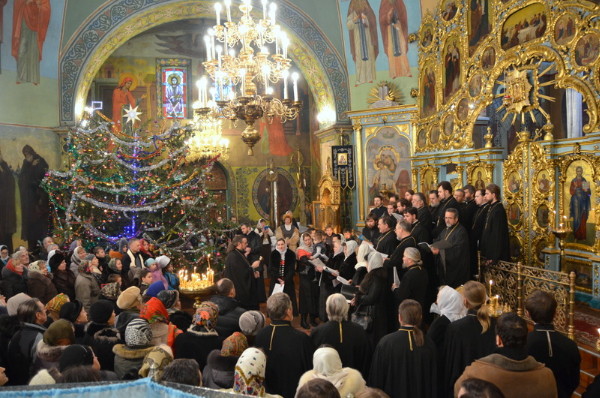Liturgy, Divine
Liturgy, Divine (Божественна Літургія; Bozhestvenna Liturhiia). A eucharistic church service performed by a priest or bishop, with the assistance of a deacon; known commonly as the Mass in the Latin rite. The most fundamental of Christian church services, the Divine Liturgy symbolically commemorates the earthly life, death, and resurrection of Jesus Christ. The four Divine Liturgies used by Ukrainians date from the 4th century but acquired their present format in the 9th century. The Divine Liturgy of Saint John Chrysostom is the most commonly used and is celebrated on Sundays and weekdays. The Divine Liturgy of Saint Basil the Great is observed 10 times a year and is distinguished mainly by the longer silent prayers said by the priest. The Divine Liturgy of the Presanctified Gifts is performed on Wednesdays and Fridays during the Great Lent and on the first days of the week preceding Easter. It is notable for using eucharistic species consecrated during a previous Liturgy. The Divine Liturgy of the Holy Apostle Jacob (James) is celebrated once a year, on his feast day (5 November [23 October OS]).
The Divine Liturgy might be described as a series of connected prayer sequences or as the divine drama (leitourgia). It is celebrated in three parts: (1) the prayers of entry, with vesting and Proscomydiia (Prothesis); (2) the Liturgy of the Catechumens or the Word; and (3) the Liturgy of the Faithful or the Eucharist, which includes the Anaphora and Communion. Proscomydiia is an elaborate rite during which the priest prepares the bread and wine to be used in the Communion. The Liturgy of the Catechumens begins with the Great Litany of Peace, includes the processional entrance of the priest with the Gospel, and is centered around the reading of the New Testament letters (the Apostolos) and Gospel and a sermon or a homily. It concludes with the admonition of the catechumens (unbaptized) to leave; they are not permitted to participate in the rest of the service. The Liturgy of the Faithful reaches its climax during the Anaphora, which is centered around transubstantiation or the transformation of the bread and wine into the Body and Blood of Jesus Christ (consecration). It is followed by the Communion or distribution of the consecrated species among the congregation of believers. It includes the recitation of the Creed and the Lord's Prayer. The texts of the Liturgies can be found in a Liturgicon.
The Ukrainian celebration of the Liturgy involves numerous well-developed practices, including the assistance of deacons in the service (when they are available), a pronounced spatial division between priest and congregation (accented during certain portions of the Liturgy by the opening or closing of the middle or Royal Gates of the iconostasis), symbolic processions by the bishop or a priest and his retinue around the altar, and the extensive use of candles and incense. Likewise, the choral accompaniment to the Liturgy is well defined and highly regarded (see Church music). Additional services commemorating feast days or other occasions are commonly performed separately from but in conjunction with the Liturgy (see Church holidays).
The Ukrainian Orthodox church and Ukrainian Catholic church, like all Eastern Slavic churches, maintain their own specific ritual forms in celebrating the Divine Liturgy. These are particularly evident if compared to the liturgical norms of the Russian Orthodox church. The priest in a Ukrainian church, for example, traditionally reads the Gospel facing the congregation, while in the Russian church he is turned away from them; moreover, the Ukrainian priest keeps the Royal Gates of the iconostasis open considerably longer than does the Russian. After the subjugation of the Ukrainian Orthodox to the Russian Orthodox church in the 18th century, numerous Russian elements were introduced into the Liturgy. The Ukrainian Autocephalous Orthodox church that emerged after 1917 reformed the Liturgy (including abbreviations) and revived many old Ukrainian traditions. These traditions are now observed by most Ukrainian Orthodox jurisdictions in the West, but the official Ukrainian Orthodox church under the Moscow patriarch retains many Russian elements in its Liturgy.
In Galicia, Ukrainian Catholic liturgical practice was subjected to Latinizing influences through Polish Roman Catholicism until the end of the 19th century. The Lviv Synod of 1891 undertook a number of reforms intended to restore a more traditional form of observance, but with only limited success. In the late 1920s Metropolitan Andrei Sheptytsky also favored a return to traditional practices, and a special commission tried to standardize liturgical practices. More recently, the Liturgical Commission under the Congregation for Eastern Churches at the Vatican published authoritative editions of the three major Liturgies used in the Ukrainian Catholic church, which have given rise to greatly increased standardization since the 1960s.
BIBLIOGRAPHY
Fedoriv, Iu. Obriady Ukraïns’koï Tserkvy: Istorychnyi rozvytok i poiasnennia (Rome–Toronto 1970)
Solovey, M. The Byzantine Divine Liturgy: History and Commentary, trans D. Wysochansky, (Washington, DC 1970)
Kucharek, C. The Byzantine-Slav Liturgy of St John Chrysostom: Its Origin and Evolution (Allendale, NJ–Combermere, Ont 1971)
Schulz, H. The Byzantine Liturgy: Symbolic Structure and Faith Expression (New York 1986)
Ivan Korovytsky
[This article originally appeared in the Encyclopedia of Ukraine, vol. 3 (1993).]

